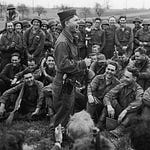World War II is so rife with stories that it seems we’ll never get over reliving that war.
Historians bring new focus, often mining fresh material made available through the declassification of material only recently made available. “As we lose the survivors and governments grapple with their role in the war, new documents continue to be declassified and released,” noted Sarah Rose, author of D-Day Girls.
Rose’s work profiles women “drafted” into the war effort in England in 1942 during a dark time for the last country left in Europe to defy the Nazi threat. Britain had a manpower problem. Thousands of British soldiers, having narrowly escaped capture at Dunkirk, were already in action around the globe. If England was going to stir trouble in conquered France, it would need help.
Rose paints a vivid picture of what it meant to live in an occupied country where 2 million French soldiers had been taken as prisoners of war and where French agriculture and industry now served Germany.
One of the undeniable facts that Rose makes is that France collaborated with the Nazis during the occupation, building half the aircraft that bombed the Allies and turning on its Jewish population, sending 76,000 Jews to their deaths in extermination camps. It’s also a fact that 650,000 French men were conscripted for slave labor in Germany during the war.
A review of some of the resistance efforts to Nazi control in France includes small victories and punishing defeats. Saboteurs operating undercover in France not only had to defy the Gestapo but work in an environment of distrust, said Rose. Any suspicious activity might attract the attention of starving French villagers who were encouraged to inform.
While Rose outlines some of what worked and what didn’t, one thing is clear: women, often forgotten during wartime, played their part.
Certainly, Lise de Baissac did, rising to second-in-command (to brother Claude), and overseeing 20,000 agents at the time of the D-Day invasion.
Those agents went into action before the first ship landed in Normandy, demolishing a train junction while destroying telephone and teleprinter cables all along the Normandy coast. “Throughout France on the night of June 5, 1944, there were some 950 cuts on French railways using explosives dropped by the Firm,” wrote Rose. The Firm was the name given to the Special Operations Executive, the “ungentlemanly” secret organization that trained 39 women to stir resistance in France.
Heavy fighting persisted after D-Day but 11 months after the invasion, Germany fell.
Some of the things I learned in Rose’s book include the following:
--With a shortage of gasoline, the bicycle was the true weapon of the Resistance, costing as much as a new car and regulated with license plates.
--The BBC played a huge role in communicating information—and spy codes—across Europe.
--The British dropped pamphlets over France during the war—spreading propaganda to buoy the hopes of the conquered—and providing cover for the occasional air drops of agents into the French countryside.
--Starvation diminished France: one-third of children born during the war had stunted growth; three-pound newborns were common.
Rose, incidentally, is working on another book regarding WWII, this one outlining how Denmark “saved its Jews,” she said, describing the Danish effort as due to “a nation of Anne Franks.”















Share this post